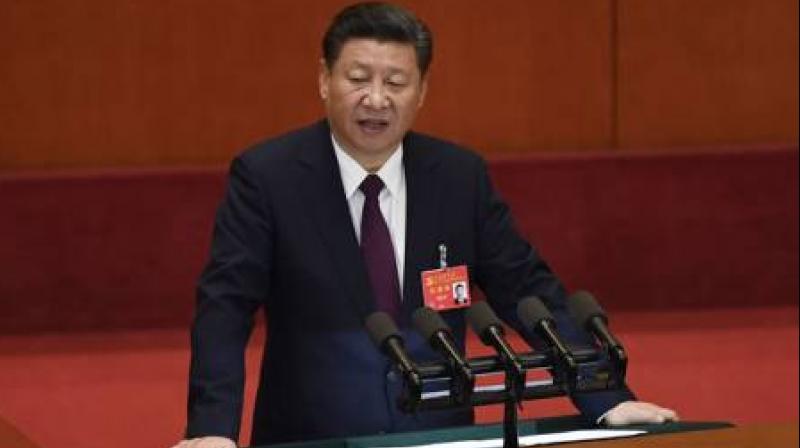Beijing's defence budget unveils grand security ambitions

More than the figure, it is the intent behind the figure that matters. In a rather modest rise compared to its 2017 defence budget, Beijing has decided to increase its defence budget by 8.1 per cent in 2018. The 2017 defence budget was 7 per cent while the 2016 and 2015 figures were 7.6 per cent and 10.1 per cent respectively. Setting the goal to build a stronger armed force for the “new era”, the hike in the 2018 defence budget was projected by Premier Li Keqiang to meet the challenges emerging from the “profound changes in the national security environment” that China is facing. What are these “profound changes”?
The Chinese firmness to establish a stronger armed force is not new. The Chinese leadership defends this rise by stating that China’s total defence budget is $175 billion, one-fourth of the United States budget, which is $716 billion, making it non-impressive and below par. So, this rise in the military budget is neither meant to engage in an arms race nor is it large enough to match with a superior military such as the US. In order to narrow the gap, Beijing’s strategy is to focus on economic modernisation, which can direct sustained high rates of investment in the defence sector. Chinese state media further contend that the country must aim to increase the budget to 20 to 30 per cent to emerge as a stronger military power with greater influence. There is obviously merit in this Chinese contention, but it becomes provocative when China links this increase to “profound changes” in the security environment. It points towards a grand Chinese thinking that is associated with its ambitions in the immediate Indo-Pacific, in particular, to the ongoing People’s Liberation Army reforms, defence strategy and security ambitions.
Increase in China’s defence budget is indeed closely linked to the goal of transforming the PLA into a “modern, mechanised, IT-based force”. The emphasis is being offered to bring qualitative changes in the PLA, both on the technological and operational fronts. A continuous “technological revolution” is taking place in modernising the PLA for a “new era” where the military emphasis is on “information warfare”. This points to the overall development, adoption and integration of micro-electronic technologies into weapons, precision-guided weapons and IT-based C4ISR system, in areas like artificial intelligence and Nano technology. The PLA reform is at the heart behind the rise of China’s defence budget, but this reform is not taking place in isolation. The military leadership has always foreseen that a stronger and professional military is the key to challenge US supremacy. The main target therefore is to improve China’s Comprehensive National Power (CNP), essentially to improve its economic, diplomatic and military prowess, and guarantee China its rightful place as a power at par with the US.
The reference to the “profound changes” is therefore linked to the recent security developments in the Indo-Pacific that are closely associated with China’s international maritime and security ambitions. The emphasis is given to maritime zones, building maritime and military capability, protecting maritime networks, and creating alternative maritime supply routes in the Indian Ocean. Along with the South China Sea, the Strait of Malacca and the Arabian Sea, the Indian Ocean is factored highly as a “maritime lifeline”. As a result, Beijing has been closely observing the security developments in Indo-Pacific, with special emphasis on the Indian Ocean. There is a continuous stress to promote China as a maritime power, where the immediate aim is to have a superior numerical strength which increases China’s maritime influence. This is intended to alter the balance of power equation in Indo-Pacific, where the US naval presence continues to remain the dominant force along with the increasing maritime understanding between India and Japan. The revival of the idea of the “Quadrilateral” initiative involving Australia, India, Japan and the US has further encouraged the Chinese security apparatus to focus more intently on the Indo-Pacific region. Donald Trump’s 2017 National Security Strategy (NSS) report has also strengthened the Chinese resoluteness since the US increasingly views China as a “revisionist power”.
China’s “revisionism” in military strategy is visible in Beijing’s international thinking in the Indian Ocean Region (IOR). The immediate target is to enhance its international profile as an advanced military. The recent deployment of the J-20 stealth fighters is a fine reference to this effect. Chinese officials were quoted stating proudly that the J-20 is aimed at safeguarding China’s “sovereignty, security and territorial integrity”. Likewise, the new intercontinental ballistic missile Dongfeng-41, which is to be launched this year, is aimed at boosting China’s profile as a missile power. The electromagnetic railgun if developed will make China the first country to test such a weapon at the sea. The emphasis is offered in strengthening China’s technological capability in artificial intelligence, quantum information science, hypersonic technology, electromagnetic technology and supercomputing. These technological advancements are closely linked to China’s defence budget and Xi Jinping’s international security ambitions to put forth a strong military dream.
In fact, the changing security conditions in Indo-Pacific have constantly encouraged the Chinese leadership to increase the defence budget despite the slow growth rate in the Chinese economy. The reference to “profound changes”, however, points to a more interesting fact: Beijing’s defence budget and military dream are both complementary to each other. China’s defence budget is critically discussed due to its non-transparency. The non-accounting of the budget allocated in military research and development, arms imports, nuclear forces and strategic rocket programme, budget spent for the People’s Armed Police (PAP) to the overall defence budget have always been debated internationally. Likewise, Beijing’s military ambitions in the IOR are fast growing where Beijing is gradually establishing a number of military and strategic bases. China’s naval base in Djibouti is a fitting reference to this effect. The Maritime Silk Road (MSR) facilitates the Chinese Navy to stay focused in the Indian Ocean. Besides, what needs to be understood is that China’s military goals are not military per se, these are rather institutional foreign policy and national security centric goals tied to its national objectives. As a result, the Chinese military is in a position today to assert itself on defending territories and securing the country’s interests.
Beijing’s defence strategy and military planning has been mainly intended over the years to dissuade the US capability of supporting Taiwan and coerce the latter into unification. There seems to be a subtle change in this priority that is reflected in China’s “profound change” reference while announcing the defence budget. The change is more towards enhancing military presence and enriching the maritime-military strategy in the Indo-Pacific region.

